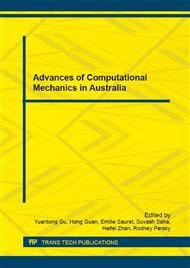p.1
p.7
p.12
p.18
p.23
p.30
p.36
p.42
p.48
CFD Analysis of Early Diaphragm Removal in Expansion Tubes
Abstract:
Impulse facilities generate transient high-velocity gas flows for ground testing in aerodynamics. The expansion tube is the facility type with the highest performance capability in terms of total flow enthalpy and total pressure, and is particularly useful for studies of atmospheric re-entry, chemical kinetics, scramjet flight and supersonic combustion. In operation, a thin film diaphragm that initially partitions two tube sections is required to rupture under the force of a shock-wave. Fragmented pieces are accelerated with the flow and can damage test models and instrumentation, and the rupture process itself affects flow properties. It has been proposed to replace the diaphragm with a fast open valve that clears the tube prior to shock arrival. This paper investigates the effect of early valve opening on the test flow.An inviscid, axisymmetric model was created using Eilmer3, a compressible CFD solver developed at the University of Queensland. Early valve opening was simulated at varying times for instantaneous diaphragm removal. The result was the formation of a secondary shock and expansion wave. The primary shockwave reaches the test section at a higher velocity due to passing through the expansion wave, creating a faster, higher-pressure test flow, but also higher temperature, leading to substantially reduced Mach number. The interactions with the secondary waves were found to cause unsteadiness in test flow properties.
Info:
Periodical:
Pages:
23-29
Citation:
Online since:
July 2016
Authors:
Keywords:
Price:
Сopyright:
© 2016 Trans Tech Publications Ltd. All Rights Reserved
Share:
Citation:


